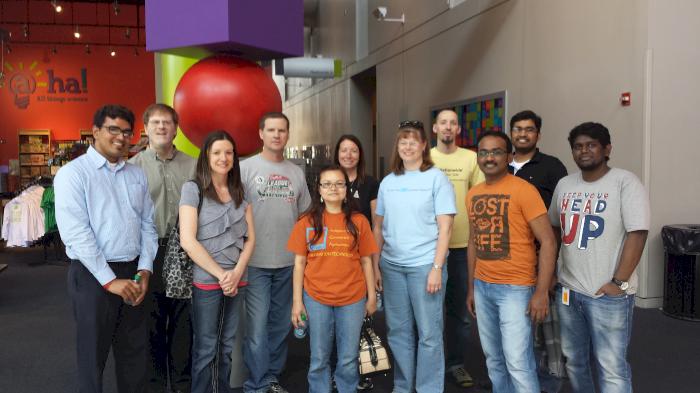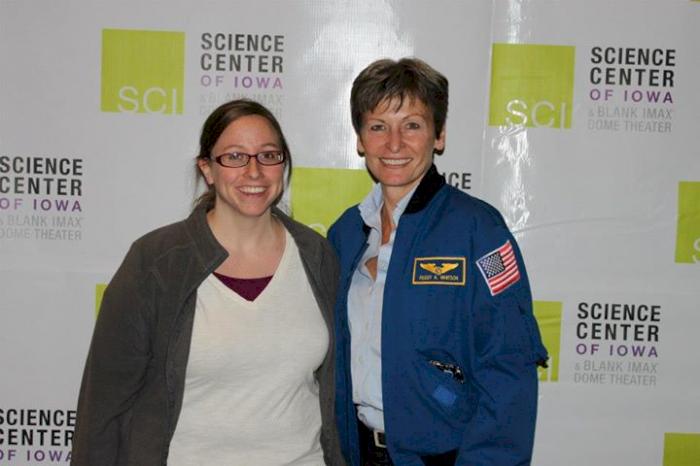Dr. Sarah Willis was browsing children’s astronomy books online and noticed a trend: Nearly every title featured the planets in our solar system — but nothing beyond. Willis turned to her doctoral dissertation for inspiration for her first children’s book, A Place in Space, an engaging literary journey of a girl and her feline friend through space.
SCI caught up with Willis, a former volunteer and current post-doctoral fellow at the Harvard-Smithsonian Center for Astrophysics, on her new book, her post-doctoral research and, of course, her excitement for the Hubble Space Telescope’s upcoming anniversary.
SCI: What drew you to science growing up?
SW: I would say it was just immersion. My parents and grandparents were always giving my sister and me books on science and television programs on science. We got a very technical science magazine that I always loved reading when I was a kid, even though I didn’t necessarily understand everything.
SCI: Was there a particular A-ha! moment when you realized astronomy was the right field for you?
SW: In high school, I sort of stumbled upon it because I wanted to colonize space — Mars, specifically. After reading way too much science fiction, I decided studying astronomy would be a great way to accomplish that. I eventually decided colonizing Mars might not quite happen in our lifetime, but I still thought astronomy was pretty cool.
SCI: There’s often a common misconception that a scientist is someone who wears goggles and spends the day mixing chemicals in a lab. How do you strive to go beyond that notion in your work?
SW: I’ve certainly done a lot of outreach to meet people in the community and bring a team of STEM professionals to demonstrate that scientists are real people, and we come from all kinds of different backgrounds with all kinds of different interests.
SCI: What motivated you to volunteer at SCI?
SW: A friend and I just thought it would be cool. We were both in grad school at the time, and we both started volunteering and found it was a lot of fun. We started off in exhibits. The Star Parties were just getting started when I was volunteering there, so we helped get those running. When theFacing Marstraveling exhibit arrived, I was super excited to be able to help out with it.
The Portal to the Public program was also starting while I was there. I was one of the first scientists to participate in the program. That was a really good experience.
SCI:Why is it important for children to see scientists as real people with diverse backgrounds and interests?
SW: There’s a lot of focus on trying to increase the diversity of scientists today because scientists come from many different backgrounds and have different perspectives. It’s important to get those different viewpoints in the actual scientific community. It helps us fuel creativity and understand the world around us in new ways.
SCI: Besides your formal work as a researcher, you’ve contributed to astronomy in a variety of ways, including writing a children’s book. What inspired you to take on that type of creative project?
SW: I was reading for fun, and I started thinking of ways I could make rhymes about my dissertation research I had just finished. I thought it would be fun to finish that up and illustrate it. When I was looking online, I saw there were a lot of books for kids on the planets in our solar system and very basic astronomy things, but I didn’t see a lot of things available for younger readers about anything else in our solar system.
SCI: What was it like to take your doctoral research and distill it into something that’s accessible for children?
SW: It’s something I really enjoy. Obviously, it doesn’t go into a lot of specific details of my actual research work. It uses an object I studied a lot, which is the Cat’s Paw Nebula. It’s an area where a lot of young stars are forming, and that’s what my research focuses on. It’s a really captivating object visually, and I really like the ability to play on the fact that cats are something kids can appreciate and enjoy, and you can tie that to something so abstract.
SCI: What was the most challenging aspect of writing A Place in Space?
SW: Coming up with a coherent way to try to explain the whole life cycle of a star and keep it at a level kids could understand.
SCI: The Hubble Space Telescope will celebrate its 25th anniversary on April 24. How has it impacted astronomy and STEM as a whole?
SW: Hubble has been fantastic because the images it produces are so good at providing exposure not just for astronomy but for science in general. Anyone can look at those images and see just how beautiful and amazing the universe is. When you learn about the science behind what makes those objects exist, it makes it even cooler.


